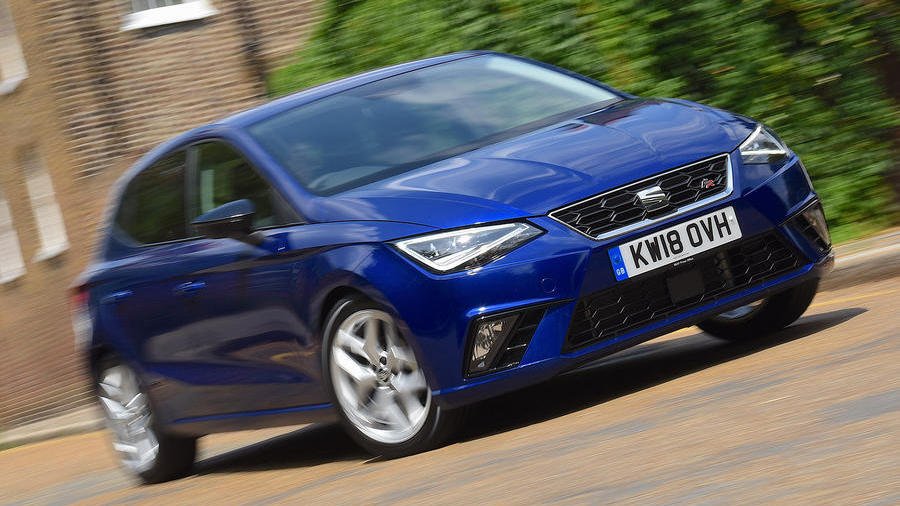This fifth-generation Seat Ibiza model was launched in 2017 and established itself as a competitive player, thanks in part to its distinctive styling and spacious interior.
Initial engine choices were three 1.0-litre petrols, two 1.6 diesels and a 148bhp 1.5 petrol. The line-up was later streamlined to the 1.0 80, 95 and 115 petrols and the 1.6 TDI 95. In time the diesel was dropped, and a 1.0 110 petrol has recently replaced the 115.
Entry-level S cars got 15in steel wheels, a height-adjustable driver’s seat, Bluetooth and hill hold control as standard, plus a 5.0in monochrome infotainment system. SE models added 15in alloys, a leather-clad steering wheel and gearlever and colour infotainment. SE Technology received Seat’s 8.0in touchscreen infotainment, with satnav and a CD player, plus ambient interior lighting, while SE Design cars came with 16in wheels, chrome exterior trim, a panoramic sunroof and a 300W Beats audio system.
Sporty FR models included smartphone integration, 17in wheels, gloss black exterior trim, a twin exhaust system, sports seats and suspension, DAB radio and cruise control. Xcellence featured more convenience, with rear parking sensors, dual-zone climate control, keyless entry and ignition and a rearview camera. Top-rung Xcellence Lux added adaptive cruise control.
On the road, the 1.0 95 pulls smoothly from low revs and doesn’t feel as feeble as the 1.0 80 can. The 1.0 115 is punchier still, although a little pricey for the extra oomph. The 1.5 is a real flyer, but there are fewer of these on the used market.
Ride and handling are where the Ibiza shines. It feels composed and grown-up, superior to many close rivals. Motorway driving is settled and road and wind noise are minimal. The steering is light but communicative and there’s plenty of grip, and while the handling is safe and predictable, it borders on good fun. All models have a slick gearchange, and the petrol engines are the most refined at all speeds.
Inside, the Ibiza has lots of space for a small car, with plenty of front and rear leg room and a huge boot. The rear seats are most comfortable for two passengers, but for short trips you can accommodate three.
The Ibiza has many safety features as standard, such as automatic emergency braking, six airbags and active head restraints.
Need to know
Prices start at £7000 for a 2017 car with average mileage and an entry-level petrol engine. Spend £9000-£11,000 to get a 2018 car with a more powerful unit. Up the budget to £14,000 for a 2020 or 2021 1.0 95 with desirable FR trim.
The Ibiza was awarded five stars in its Euro NCAP crash test, with particularly strong scores for adult occupancy protection and pedestrian safety.
It ranked 14th out of 24 small cars in our sister mag What Car?’s latest reliability survey.
The diesel engines are impressively frugal, if a little gruff, with 57.6mpg under WLTP tests. The 1.0 95 and 1.0 115 returned official figures of 52.3mpg.
FR and Xcellence trims feature tiredness recognition and an alarm.
Our pick
1.0 95 FR: The 1.0 95 engine is refined and punchy from low revs and can propel the Ibiza to 60mph from rest in 10 seconds – a respectable time for the small car class.
Wild card
1.0 TSI 115 XCELLENCE LUX: Splash out on Xcellence Lux trim for a rear-view camera, adaptive cruise control and keyless entry and ignition. The 115 is the most potent petrol engine that is readily available and delivers impressive refinement.
Ones we found
2017 Seat Ibiza 1.0 S, 35,000 miles, £6849
2019 Seat Ibiza 1.0 TSI 95 SE, 18,000 miles, £10,600
2021 Seat Ibiza 1.0 TSI 110 Xcellence Lux, 400 miles, £16,650
Trinity Francis

